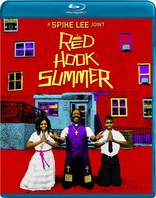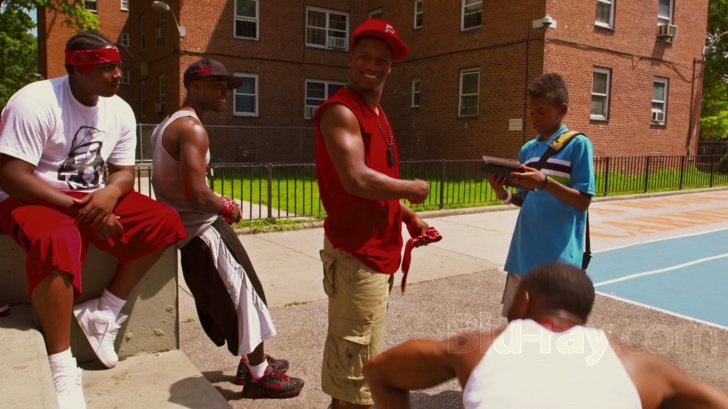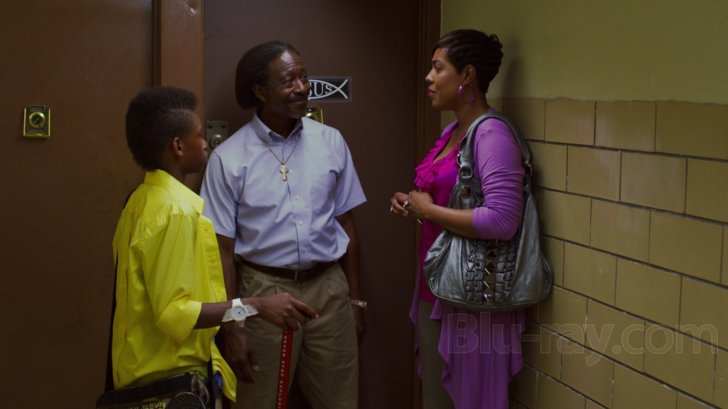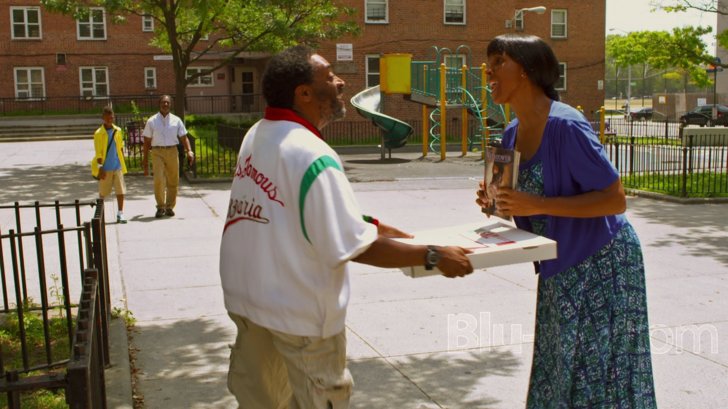Red Hook Summer Blu-ray Movie
HomeRed Hook Summer Blu-ray Movie 
Image Entertainment | 2012 | 121 min | Rated R | Dec 21, 2012
Movie rating
5.9 | / 10 |
Blu-ray rating
| Users | 5.0 | |
| Reviewer | 4.0 | |
| Overall | 4.9 |
Overview
Red Hook Summer (2012)
Flik Royale, a sullen boy from middle-class Atlanta, spends the summer with the religious grandfather he's never met before, Bishop Enoch Rouse, in the housing projects of Brooklyn's Red Hook district.
Starring: Clarke Peters, Nate Parker, Thomas Jefferson Byrd, Jules Brown (III), Toni LysaithDirector: Spike Lee
| Drama | Uncertain |
| Comedy | Uncertain |
| Thriller | Uncertain |
Specifications
Video
Video codec: MPEG-4 AVC
Video resolution: 1080p
Aspect ratio: 1.78:1
Original aspect ratio: 1.85:1
Audio
English: DTS-HD Master Audio 5.1
Subtitles
English SDH, Spanish
Discs
50GB Blu-ray Disc
Single disc (1 BD)
Packaging
Slipcover in original pressing
Playback
Region A (locked)
Review
Rating summary
| Movie | 4.0 | |
| Video | 4.5 | |
| Audio | 4.5 | |
| Extras | 3.5 | |
| Overall | 4.0 |
Red Hook Summer Blu-ray Movie Review
In Transition
Reviewed by Michael Reuben December 21, 2012Two familiar characters from previous Spike Lee films make cameo appearances in Red Hook Summer, the latest in what Lee calls his "Chronicles of Brooklyn" series. The first is Mother Darling, played by Tracy Camilla Johns. Twenty-six years earlier, she was called "Nola Darling", and she was busily juggling three men as the ambivalent heroine of Lee's debut film, and first Brooklyn Chronicle, She's Gotta Have It (1986). But priorities change with the passing years. Today "Mother" Darling is a Jehovah's Witness who greets each passerby with a smile and a copy of The Watchtower magazine. The other character is pizza deliveryman Mookie from Do the Right Thing (1989), still played by Lee himself and still wearing the same (the very same) shirt sporting the red, white and green of the Italian flag and the familiar logo of Sal's Famous Pizza. But this isn't the same Mookie around whom so many pivotal events revolved in what remains Lee's best-known film. This fellow is carrying a few more pounds on his frame, and his beard is flecked with gray. Having relocated from Bed-Stuy to Red Hook (where, presumably, Sal and his family reopened their establishment), Mookie no longer pauses to chat with the local citizenry as he hurries on his rounds. "I got to get paid!" he calls over his shoulder, and then he's gone, almost as fast as he arrived. The transformations wrought by time on both people and places are very much on the minds of Lee and his co-writer and co-producer, James McBride, author of the screenplay for Lee's previous film, Miracle at St. Anna, based on McBride's novel. McBride was raised in Red Hook and worshipped at the Baptist church featured in the film. Lee grew up in nearby Cobble Hill and has spent much of his adult life exploring Brooklyn cinematically. An elegiac sense of loss drifts through the film, as Lee and McBride capture the last vestiges of an era they know is over, seen through the eyes of a new generation that's looking forward—and should be. On the commentary track, Lee relates how the film was born when he and McBride, both fathers of teenagers, agreed that they weren't seeing any contemporary movies with characters that resembled their kids. So they decided to make one. However, as they demonstrated in Miracle of St. Anna, Lee and McBride are fond of telling stories within stories; so they surrounded their teenage characters with a richly elaborated world of character and incident that is almost too much for one movie. (Many reviewers would leave out the "almost".) I would argue, though, that the plenitude of Red Hook Summer is essential to the project that Lee and McBride undertook. Their idea of a realistic portrait of contemporary youth required a context—and that includes a larger community and a past, even if some of that past is very bad indeed.

Red Hook Summer opens with the classic device of a stranger's arrival. He's twelve-year-old Curtis "Flik" Royale (Jules Brown) from Atlanta, and his mother, Colleen (De'Adre Aziza), is leaving him in Red Hook to spend the summer with her father, a Baptist preacher known as Bishop Enoch (the great Clarke Peters, currently starring on Treme), whom Flik has never met. Right at the film's outset, questions are raised about the family's troubled history, as Colleen tells her cab driver to wait while she introduces her father to her son on Bishop Enoch's threshold, then rushes back to the airport to catch a return flight, declining even to enter her father's apartment. Some of those questions are eventually answered; some are left for viewers to ponder after the film ends. Flik doesn't want to be in Brooklyn, he doesn't want to be put to work in his grandfather's church, known as "Lil' Peace of Heaven" ("Lil' Heaven" for short), and he certainly doesn't want to live in a place where Jesus is the main topic of conversation. Since he's stuck in Red Hook, he puts his iPad 2 in front of his face like a defensive perimeter. (Some of the video footage shot by Jules Brown in character made it into the movie.) As Flik trudges reluctantly through his days in exile, we get his outsider's view of the inhabitants who form his grandfather's circle and, through them, glimpses of a community struggling with poverty and unemployment. (But not major crime; this is the modern New York City.) Lil' Heaven is fighting to survive, its congregation thinned by the forces of gentrification, and its finances strained by a falloff in donations as former members die or move away. The Bishop's long-time assistant, Deacon Zee (Thomas Jefferson Boyd), daily reads the Wall Street Journal and loudly excoriates everyone for the marvelous investments they failed to make when he told them to (e.g., GM just before the government bailout). But the Deacon never explains why he's still broke. (Maybe it's all the drinking.) His sister, Sharon Morningstar (Heather Simms), is one of Bishop Enoch's most devoted parishioners, and she'd like to be more to the Bishop, but her first priority in life is her teenage daughter, Chazz (Toni Lysaith). Having lost one daughter to AIDS, Sister Sharon is determined to "do it right" this time, and she is keeping a watchful eye on Chazz—even more so after Chazz begins acting as Flik's guide to Red Hook. The importance of knowing what places to avoid becomes evident after Flik's first run-in with Box (Nate Parker) and his crew, who are the local dealers, enforcers and, of course, aspiring rappers. The central presence in Flik's experience of Red Hook remains his grandfather. Clarke Peters delivers a towering performance as the struggling Bishop Enoch, who, as Sister Sharon says at one point, has "a story", though no one knows it. (The "story" emerges late in the film in a sequence that, viewers should be warned, is difficult to watch.) The Bishop delivers three sermons during the course of Red Hook Summer, and co-writer McBride has scripted them with the authenticity of someone raised in the Baptist faith by a preacher father. Bishop Enoch delivers these orations with the urgency of a man who is himself desperately in need of salvation, and Lee shoots the sequences with a vibrance that fully captures the "call and response" rhythms derived from centuries of tradition. What do those traditions mean today, as Lil' Heaven falls into disrepair, the Good Book is replaced by an app and a new start is next to impossible because your past can always find you? The film doesn't offer any answers except faith in the next generation. In a simple but crucial scene, Bishop Enoch and Sister Sharon sit quietly together, and Sister Sharon admits that it's all talk when they tell their kids how much better everyone behaved in the old days. Now, she places her hope in the future. The Mookies, the Nola Darlings and, yes, the Bishop Enochs have had their time. It's up to Flik and Chazz to make something of the world.
Red Hook Summer Blu-ray Movie, Video Quality 

Red Hook Summer was shot primarily on a Sony F-3 digital camera, with inserts filmed in Super8 (they're easy to spot). The cinematographer was Kerwin DeVonish, who was the camera operator on Inside Man and, according to Lee, is an expert at shooting while moving. Indeed, although the film has a lot of handheld photography, none of it feels jerky or intrusive. Image has produced a fine Blu-ray featuring a sharp, detailed and gorgeously colorful 1080p, AVC-encoded picture. Spike Lee has long been known for intense, sometimes surreal color schemes, and in his early films with cinematographer Ernest Dickerson, the pair often pushed stocks and exposures into risky territory that could be a challenge to reproduce on video formats. Digital acquisition and post-production have provided the director more precise tools for achieving his ends. The Brooklyn of Red Hook Summer has all the eye-popping, saturated hues one has come to expect from Lee's Brooklyn films, without obscuring any of the rundown conditions of Bishop Enoch's housing project, his Lil' Heaven church or such memorable details as the king-size Brooklyn rat (a dead one) with which Flik terrorizes Chazz. Whether it's the red accents preferred by Box and his crew, the purple attire favored by the Bishop at his sermons or the various bright shades adorning the congregants, the Blu-ray balances them correctly against solid blacks, well-adjusted contrast and excellent shadow detail. The brief Super8 inserts are, by design, far less detailed and have a softer, more diffused texture, but the colors remain intense. With the film itself running just over two hours and over half an hour of extras in HD, Image has thankfully not compromised but has granted the film the breathing room of a BD-50. The extra real estate no doubt contributes to the superlative picture quality.
Red Hook Summer Blu-ray Movie, Audio Quality 

The surround mix contained in the film's DTS-HD MA 5.1 track is less concerned with evoking naturalistic environments than with deepening the impact of key scenes, especially the sermons of Bishop Enoch. The sense of "call and response" during the Bishop's preaching is enhanced by the viewer's immersion in the voices, as if one were part of the congregation. During an especially intense moment of the Bishop's appeal toward heaven, his voice expands into the surrounds, doubling and bouncing back to him, as if it were reverberating from the skies (or perhaps he only imagines it to be so). Voices sometimes arrive unexpectedly from off camera in other settings, usually involving someone with a guilty secret, e.g., when Flix and Chazz are raiding the church's snack supplies. As in most Spike Lee films, the score is distinctive and plays a key role in setting the tone. Here, the piano-dominated instrumentals have been supplied by Bruce Hornsby, and they've been mixed to have the presence of a narrator's voice without words. Singer-songwriter Judith Hill has supplied several original songs; both she and they sound terrific.
Red Hook Summer Blu-ray Movie, Special Features and Extras 

- Commentary with Director/Co-Writer Spike Lee: Lee provides an easygoing, informative commentary describing the history of the project and the details of the shoot, replete with insider's anecdotes and observations about the Brooklyn locales where the company filmed during its tight production schedule. Like most good directors, Lee is also a first-rate viewer, and he is constantly interrupting himself to point out a notable detail of performance, cinematography or editing and to praise the appropriate cast or crew member. His enthusiasm is a reminder that one of a director's toughest jobs is to remain fresh and receptive to contributions by others, even after working on the same material for months or even years.
- Behind the Scenes (1080i; 1.78:1; 27:30): A generous portion of production footage, well-edited without any narrative or voiceover but with instrumental accompaniment by Bruce Hornsby. If you've seen the film, it's easy to spot which scene is being shot. It's the equivalent of a journal of the making of Red Hook Summer.
- Music Video (1080p; 1.78:1; 4:04): "Desperation" written and performed by Judith Hill and set to a combination of behind-the-scenes footage and clips from the film.
- Teaser (1080p; 1.78:1; 0:37): Barely a trailer, this is more an announcement that there's a film on the way.
Red Hook Summer Blu-ray Movie, Overall Score and Recommendation 

Spike Lee isn't the first filmmaker to be "typecast" because of single film's impact, but it's remarkable how many viewers treat every new project as if it were another iteration of Do the Right Thing. Lee's resumé is far more varied and interesting than a single "issue" film he made over two decades ago (an exceptionally accomplished work, by the way). Looking just at this century, there's Inside Man (2006), the sharply crafted heist film that proved Lee's ability to be a box office craftsman with the best of them. There's his intimate portrait of a convicted drug dealer (a white drug dealer, not that it should matter) in the throes of an existential crisis as he reviews his life on the day before reporting to prison (25th Hour, 2002). His war film, Miracle of St. Anna (2008), is also an extended meditation on faith and the inscrutability of God's purpose. And not many people know that Lee also directed a musical based on the Broadway hit Passing Strange (2009), about a young California musician traveling through Europe in search of inspiration. And now there's Red Hook Summer, where characters may discuss hot-button issues, but that's not what the film is about. It's about a normal teenager who temporarily inhabits an alien world where he experiences things that will echo through the rest of his life. Challenging but recommended.
Similar titles
Similar titles you might also like

The Landlord
1970

2 Days in New York
2012

A King in New York
1957

Do the Right Thing 4K
1989

State and Main
2000

Mistress America
2015

This Must Be the Place
2011

Blue Jasmine
2013

Solitary Man
2009

A Master Builder
2013

Amira & Sam
2015

20th Century Women
2016

Shadows
1958

First Cow
2019

Hi, Mom!
1970

Local Hero
1983

The Bonfire of the Vanities
1990

Good Time
2017

A Thousand Clowns
1965

Something Wild
1986